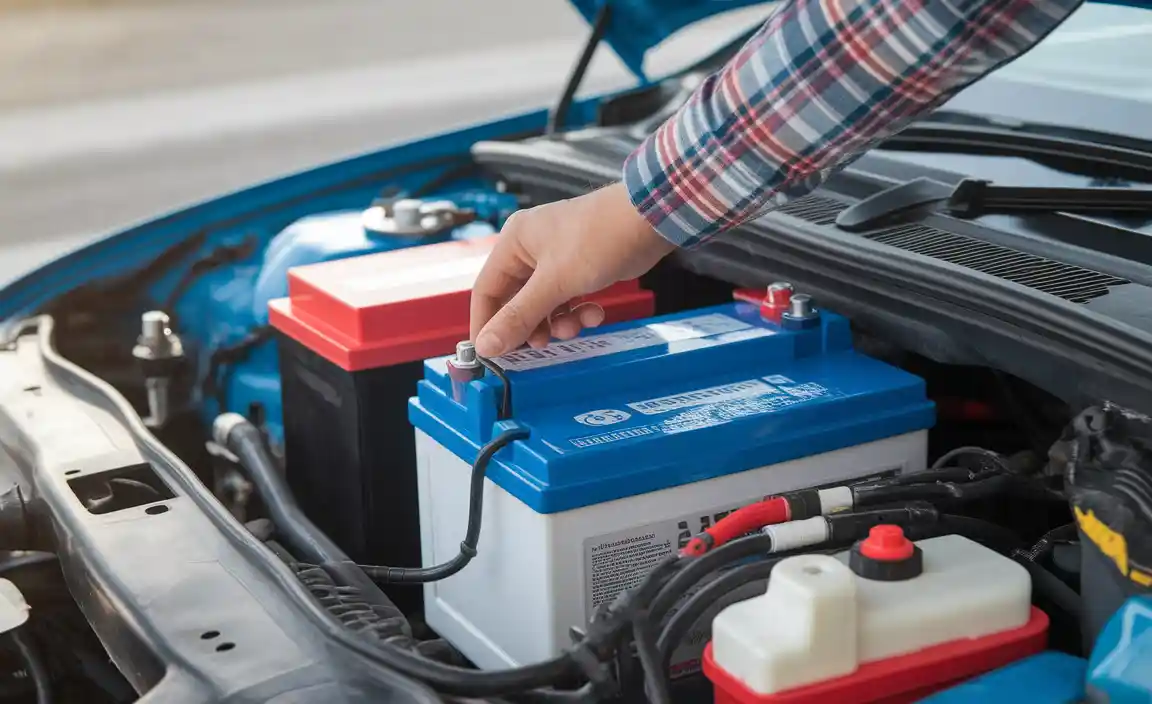Imagine you’re ready to hit the road, but your car won’t start. Frustrating, right? Often, the cause is a weak car battery. But how many volts does a car battery need to work? This is a common question among drivers.
Most car batteries supply 12 volts. It’s a small number but vital for making your car run smoothly. Did you know a fully charged battery holds about 12.6 volts or more? That’s the sweet spot! If it drops below 12 volts, your battery might struggle.

Understanding how many volts a car battery needs can save you a lot of trouble. This knowledge can help you keep your car in top shape. Are you curious about how these volts work and why they matter? Let’s dive deeper into the world of car batteries!
How Many Volts For Car Battery: Understanding Voltage Levels
A typical car battery provides 12 volts of power. This voltage is essential for starting the engine and powering electrical components. Sometimes, batteries can read around 13.7 to 14.7 volts when the engine is running. Have you ever wondered what happens if your battery’s voltage drops too low? It may fail to start your car! Knowing about volts can help you maintain your battery and avoid being stranded. Keep an eye on that voltage!
What is a Car Battery?
Definition and purpose of a car battery. Types of car batteries (leadacid, AGM, lithiumion).
A car battery is a device that provides power to start your vehicle. It stores energy as chemical power and changes it into electricity. This electricity helps your car run. There are a few main types of car batteries:
- Lead-Acid: This is the most common type. It is strong and lasts a long time.
- AGM (Absorbent Glass Mat): These are durable and don’t spill. They work well in tough conditions.
- Lithium-Ion: This type is lighter and charges quickly. It’s becoming popular.
Choosing the right battery helps keep your car running smoothly. Always check the battery type before replacing it.

What is the voltage for a car battery?
The normal voltage for a car battery is 12 volts. This is enough power to start the engine and run electronics.
Standard Voltage for Car Batteries
Explanation of the standard 12volt system. How voltage is measured in car batteries.
Most car batteries run on a standard 12-volt system. This means they have six cells, with each cell providing about 2.1 volts. When you combine them, you get 12.6 volts when fully charged. Voltage in car batteries is measured by using a multimeter. This tool helps check if the battery has enough power to start the car.
How is voltage measured in car batteries?
Voltage is measured in volts using special tools. You can check the battery’s voltage with a multimeter. A reading below 12.4 volts means the battery is not fully charged.
Components Affecting Battery Voltage
Role of cells in a car battery. Impact of temperature on battery voltage.
Inside a car battery, there are several cells that work together to create power. Each cell has its own voltage, and together they usually provide around 12 volts. However, this voltage can change. For instance, hot weather can cause the battery to run high, while cold weather might drop it down low. Imagine your battery is like a grumpy cat; it likes being cozy! A little temperature decrease can make it less cheerful and affect its performance.
| Temperature | Battery Voltage Effect |
|---|---|
| High | Increased Voltage |
| Low | Decreased Voltage |
So, keeping your battery happy and warm will ensure it has the best voltage! Think of it as giving your battery a nice blanket on a chilly day.

Signs of Voltage Issues in Car Batteries
Indicators of low voltage (e.g., dimming lights, slow engine crank). Consequences of overvoltage.
Has your car ever felt like it’s trying to wake up after a long nap? That might be a sign of low voltage! Look for dimming lights or a slow engine crank. These signs mean your battery needs help, like a sad puppy. On the flip side, overvoltage can be just as tricky. It can harm your car’s electronics, leaving them confused, kind of like a cat at a dog show.
| Voltage Issue | Sign |
|---|---|
| Low Voltage | Dimming lights, slow engine crank |
| Overvoltage | Damaged electronics, car malfunctions |
So, keep an eye on how your car behaves. It might just be telling you it needs a little TLC or a battery check-up!
How to Measure Car Battery Voltage
Tools and techniques for measuring voltage. Interpreting voltage readings.
Measuring car battery voltage is simple and fun! First, you need a multimeter, the superhero tool for this mission. Set it to DC volts. Touch the black lead to the negative terminal and the red lead to the positive terminal. Watch the numbers! A healthy battery should read between 12.4 and 12.7 volts. If it’s much lower, your battery might be sad and need some help!
| Voltage Range | Status |
|---|---|
| 12.4 – 12.7 volts | Good Battery |
| 12.0 – 12.3 volts | Needs Charging |
| Below 12.0 volts | Replace Battery! |
Understanding the readings is key. A voltage below 12 volts means trouble. It’s like your battery is throwing a tiny tantrum! Keep an eye on those numbers, and your car will be happy and start right up.
Charging and Maintaining Car Battery Voltage
Methods for charging car batteries. Maintenance tips to ensure proper voltage levels.
To keep your car battery happy, charging and maintenance are key. You can charge a car battery with a home charger or your car’s engine. Make sure to read the instructions carefully to avoid the shocking surprise of incorrect voltage! Remember to check the connections; rusty ones can ruin the fun. To keep those volts steady, clean the battery terminals and avoid short trips that drain power like a hungry squirrel!
| Charging Method | Pros | Cons |
|---|---|---|
| Home Charger | Convenient | Time-consuming |
| Engine Charging | Quick | Requires running engine |
Always check your battery’s voltage. Ideally, it should be around 12.6 volts when fully charged. A voltmeter can help with this. Regular check-ups ensure your car doesn’t get cranky when you need it most!
Common Myths About Car Battery Voltage
Debunking misconceptions (e.g., “All car batteries are 12 volts”). Understanding specific cases for different vehicle types.
Many think all car batteries are 12 volts, but that’s not true. Some vehicles, like trucks and buses, may use 24 volts or more. Understanding this helps us avoid confusion about battery needs. Remember, battery voltage can vary with vehicle type. Let’s look at some examples:
- Standard cars: usually 12 volts
- Large trucks: can be 24 volts
- Electric vehicles: may use more than 400 volts
Knowing these facts helps you choose the right battery. Don’t let myths mislead you!

What is the voltage of a typical car battery?
A typical car battery is 12 volts. However, it’s important to check your vehicle’s requirements.
What to Do When Battery Voltage is Low
Steps to take when experiencing low voltage. When to seek professional help.
If your car battery is acting like a sleepyhead and showing low voltage, don’t panic! First, check the battery connections; sometimes, they just need a little hug. Clean them if they are dirty. Next, you can try jump-starting your car. It’s like giving your battery a little caffeine boost! If your car still won’t start, it might be time to wave the white flag and call a professional. They can check if your battery needs a replacement or if there’s a deeper problem.
| Action | Description |
|---|---|
| Check Connections | Ensure they are tight and clean. |
| Jump Start | Use jumper cables to start the battery. |
| Seek Help | If problems persist, contact a mechanic. |
Future of Car Battery Technology and Voltage
Innovations in battery technology (e.g., solidstate batteries). Implications for vehicle performance and voltage standards.
Exciting things are happening in battery technology! Solid-state batteries are the new stars, promising more power without a heavy weight. Imagine your car zooming faster and lasting longer on a single charge. More voltage means better performance, and yes, fewer “fizzle-out” moments. New standards will soon make charging faster, kind of like giving your car a quick coffee boost! Buckle up for the future—car batteries are getting a thrilling upgrade!
| Battery Type | Voltage Standard | Benefits |
|---|---|---|
| Solid-State | High Voltage | Longer life, faster charging |
| Lithium-Ion | Standard Voltage | Widely used, reliable |
Conclusion
In summary, a typical car battery has 12 volts. This voltage powers your car’s starter and electronics. If you ever jump-start a car, remember to connect the cables correctly. If you’re curious about car batteries, explore more on battery maintenance. It’s a simple way to keep your car running smoothly. Keep learning and stay curious about your vehicle!
FAQs
What Is The Standard Voltage Of A Typical Car Battery?
A typical car battery usually has a voltage of 12 volts. This means it uses 12 units of electrical power. You can think of it like a big, strong battery that helps start the car. Without it, the car wouldn’t run.
How Does The Voltage Of A Car Battery Affect Its Performance?
The voltage of a car battery helps it provide power to start the engine and run other electrical parts. A healthy battery usually has about 12.6 volts or more. If the voltage drops too low, the car might not start or can have weak lights. Keeping the battery charged helps it work well and last longer.
What Factors Can Cause A Car Battery To Produce Lower Than Normal Voltage?
A car battery can make less voltage for a few reasons. One big reason is if the battery is old or worn out. If there’s a bad connection, it can also lower the power. Very cold or very hot weather can affect the battery too. Lastly, using too many electrical things in the car at once can drain the battery.
How Do You Measure The Voltage Of A Car Battery Effectively?
To measure the voltage of a car battery, you need a tool called a multimeter. First, turn the multimeter’s dial to the voltage setting. Next, place one clip on the battery’s positive terminal (the red side) and the other on the negative terminal (the black side). Look at the screen to see the number. A healthy battery should show around 12.6 volts.
What Is The Difference In Voltage Between A Lead-Acid Car Battery And A Lithium-Ion Car Battery?
A lead-acid car battery usually has a voltage of 12 volts. A lithium-ion car battery often has a voltage of around 3.7 volts per cell, but they connect in groups to reach higher voltages. So, when you use both types in cars, the lead-acid battery usually gives more power overall. That’s the main difference in voltage!
Resource:
- Multimeter Guide for Beginners: https://www.fluke.com/en-us/learn/blog/electrical/what-is-a-multimeter
- How Temperature Affects Battery Performance: https://www.batterystuff.com/kb/articles/battery-articles/battery-basics.html
- Understanding Different Car Battery Types: https://www.autobatteries.com/en-us/battery-knowledge/battery-basics
- Signs Your Battery Needs Replacing: https://www.aaa.com/autorepair/articles/how-to-know-when-to-replace-your-car-battery







